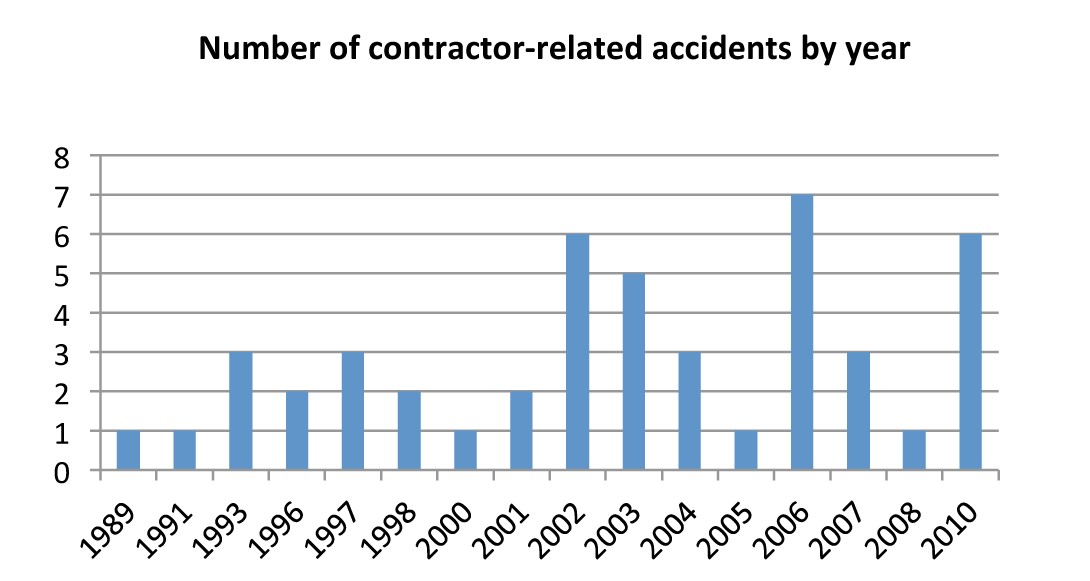KEYWORDS
------------------
Maintenance work
------------------
Permit-to-work
------------------
Welding work/hot work
-----------------
Hazard awareness/safety precautions
----------------
Alarm system
-----------------
Warning signs/function buttons
------------------
Tags/clear marking of equipment
-----------------
Equipment design
----------------
Isolation valves
----------------
Training
|
Who are contractors?
Contractors are usually those who are involved in the installation or maintenance of equipment and systems at a facility and not employees of the dangerous establishment. Their work usually associated with the regular/irregular maintenance, which is not part of the normal routine work.
Accidents involving contractors continue to occur with a regular frequency. Even as frequently (see figure below) as in 2010 there were at least 6 accidents reported involving contractors (out of around a total of 40 accidents reported in that year).

As it is illustrated in the pie-chart below about 5% of the total accident reports in the eMARS major accident database have been identified as related to contractors. In these accidents more than 60 people died and approximately the same number of people were injured.
These accidents also may involve significant production loss, as well as property or environmental damage. For example, in one of the cases profiled in this bulletin, over 50 tonnes of a dangerous substance was released, but fortunately there were no casualties. Outsourced activities may directly or indirectly create an elevated risk on a major hazard site due to inadequate attention to the interface of contract workers and the contracted activity with plant processes and storage. Maintenance, hot work, and housekeeping tasks such as cleaning and painting are common outsourced activities.

For example, contractors may be involved in tasks such as assembling pipelines or welding on storage tanks that contain dangerous substances, or pipe parts that are connected to equipment that contain, a dangerous substance.
Many of the accidents studied involving contractors were directly a result of poor training of contractors and/or poor control of the contracted work. For example, common factors associated with these accidents that elevated the risk to the contractors or of the work performed by the contractors included:
• No permit-to-work issued;
• Insufficient training of contractors;
• Insufficient communication between the operator and the contractor;
• Insufficient oversight of the work and working conditions;
• Lack of adherence to safety requirements;
• Deviation from job procedure;
• Inattention to warning signs.
However, as can be noted from the accident cases included in this bulletin, accidents involving contractors also involve inadequate control measures for the installation in question. In fact, it could be argued that an activity involving site employees could easily have triggered the event. However, operators should note carefully the differences between contract workers and their own employees. Employees regularly present on the site have a much greater knowledgebase for recognising and addressing potential site risks. Contract workers are generally not familiar with the site or installation and cannot be assumed to have much knowledge about the risks associated with the dangerous substances on the site. Risks that are obvious to employees may not be at all obvious to contract workers. Hence, to a large extent, the individual risk of contractors at a hazard installation is potentially higher than employees of the site. Therefore, it is imperative that the operator ensure that all risks in the area and associated with the contractor’s work have been identified and controlled. Furthermore, as with their own employees and the normal workflow, every effort should be made to both maintain a high level of hazard awareness and to control the risks associated with a particular activity. Standard control measures include proper training, wearing proper protective equipment, controlling access to process areas, and application of good practice measures for the work at hand, such as permitting for hot work, verification of site safety prior to beginning work and regular oversight of the work in progress.
The case studies provided in this bulletin are just a small sample of the reports available in the eMARS database involving contractors. Moreover, the situations that place contractors at high risk are numerous and these cases cannot be considered fully representative of all of them. Nonetheless, cases have been selected on the basis that they are somewhat typical of accidents involving contractors. For example, there are several accidents in the database involving contractors associated with hot work. (The eMARS number of similar accidents to the one featured have been provided below the case description when applicable).
_____________________________________________________________________________
Please note: The selected cases include a number of lessons learned, not all of which are described in this bulletin. The bulletin highlights those that it considers of most interest for this topic, with the limita- tion that full details of the accident are often not available and the les- sons learned are based on what can be deduced from the description provided. The authors thank the country representatives who provided advice to improve the descriptions of the selected cases.
|

